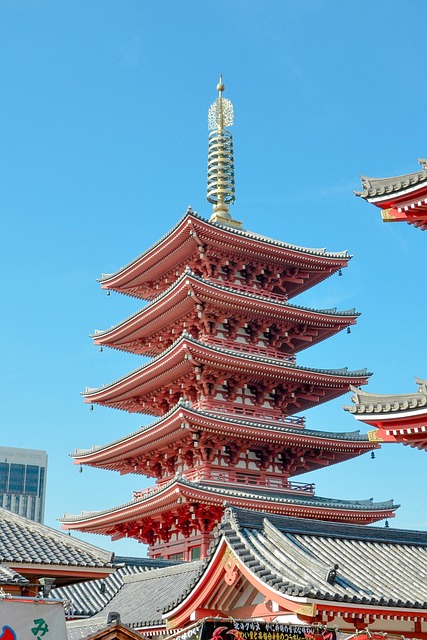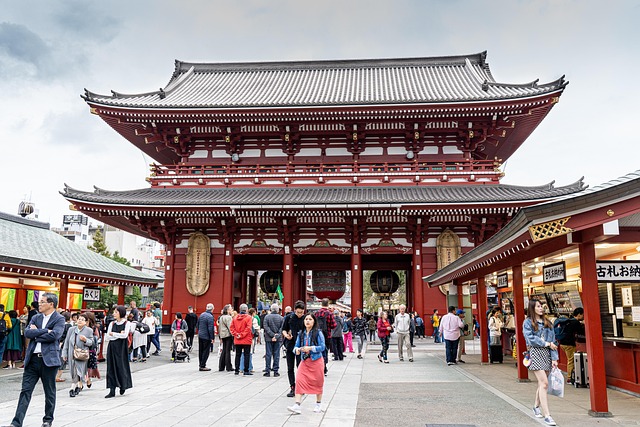In the midst of Tokyo’s modern skyline, with its gleaming skyscrapers and neon-lit districts, lies a place that seems to belong to another era. Sensō-ji Temple, located in the historic district of Asakusa, is the oldest Buddhist temple in Tokyo and one of its most beloved cultural landmarks. With a history spanning nearly 1,400 years, Sensō-ji is not only a place of worship but also a vibrant hub where spirituality, tradition, and community come together. For millions of visitors each year, both Japanese and international, it offers a chance to step into the timeless spirit of old Tokyo.
Sensō-ji in Asakusa is Tokyo’s oldest and most famous temple, where history, tradition, and vibrant street life come together.
A Temple Born of Legend

Sensō-ji’s origins date back to the year 628. According to legend, two fishermen brothers, Hinokuma Hamanari and Hinokuma Takenari, discovered a small golden statue of Kannon, the Buddhist Goddess of Mercy, while fishing in the Sumida River. Despite returning the statue to the river, it always found its way back to them. Recognizing its significance, the village chief converted his home into a temple to enshrine the statue.
This humble beginning grew into what is now Sensō-ji, making it the spiritual heart of Asakusa. Dedicated to Kannon, the temple has long been a place where people come to pray for health, happiness, and protection.
Kaminarimon: The Thunder Gate
The journey to Sensō-ji begins at its most famous landmark: the Kaminarimon, or “Thunder Gate.” Standing proudly at the entrance, this imposing gate features a massive red paper lantern inscribed with the characters for “thunder gate.” The lantern, measuring nearly four meters tall, weighs around 700 kilograms and is one of the most photographed symbols of Tokyo.
Flanking the gate are two fearsome statues of Shinto gods: Fūjin, the god of wind, and Raijin, the god of thunder. Together, they symbolize protection against natural disasters and evil spirits. Passing through the Kaminarimon, visitors immediately feel the transition from the modern city to the sacred world of the temple grounds.
Nakamise Street: A Taste of Old Edo
Beyond the gate lies Nakamise-dori, a bustling shopping street stretching about 250 meters toward the temple. This avenue has served visitors to Sensō-ji for centuries, and today it remains one of the oldest shopping streets in Japan.
The street is lined with nearly 90 stalls selling traditional crafts, souvenirs, and snacks. Here, visitors can find folding fans, yukata (summer kimono), and Edo-style toys, as well as local delicacies like ningyo-yaki (small sponge cakes filled with red bean paste) and freshly grilled senbei rice crackers.
Walking along Nakamise-dori is as much a cultural experience as visiting the temple itself, offering a glimpse into the lively marketplace atmosphere of old Edo, the former name of Tokyo.
Hōzōmon and the Main Hall
At the end of Nakamise Street rises the Hōzōmon, or “Treasure House Gate.” This massive two-story gate houses precious temple treasures and features enormous straw sandals, known as ōwaraji, which symbolize the protective strength of the guardian deities.
Beyond the Hōzōmon stands the temple’s main hall, rebuilt after being destroyed in World War II bombings. Despite the reconstruction, the hall retains its traditional architecture, with its sweeping tiled roof and vibrant red beams. Inside, the statue of Kannon is enshrined, though it is never shown to the public. Worshippers line up to throw coins into the offering box, clap their hands, and bow in prayer, following Buddhist customs.
The main hall is always lively, with the scent of incense filling the air and the sound of temple bells resonating through the grounds.
The Five-Story Pagoda and Temple Grounds
Next to the main hall stands a striking five-story pagoda, rebuilt in 1973. It is one of Tokyo’s most iconic pagodas and adds to the spiritual grandeur of the complex. Though the pagoda is not open to the public, it houses sacred relics and serves as a symbol of Buddhist faith.
The temple grounds also feature smaller shrines, gardens, and statues. One highlight is the Jizo-do Hall, dedicated to Jizo, a guardian deity of children and travelers. Seasonal flowers, such as cherry blossoms in spring and chrysanthemums in autumn, further enhance the beauty of Sensō-ji’s surroundings.
Omikuji and Rituals
Part of the charm of Sensō-ji lies in its interactive traditions. One of the most popular activities is drawing omikuji, or paper fortunes. Visitors shake a metal cylinder until a stick falls out, indicating a drawer that contains their fortune slip. Fortunes range from great blessings to dire warnings. If you receive a bad fortune, custom dictates tying the slip to a nearby rack or tree branch, leaving the misfortune behind.
Another ritual is the incense burner in front of the main hall. Worshippers wave smoke from the incense toward parts of their bodies they wish to heal, believing it has purifying and restorative powers. These simple yet profound practices allow visitors to participate in centuries-old traditions, regardless of religious background.
Festivals and Celebrations
Sensō-ji is the center of many cultural festivals, the most famous being the Sanja Matsuri, held every May. This lively Shinto-Buddhist festival honors the three men who founded the temple and features massive portable shrines, known as mikoshi, carried through the streets of Asakusa by teams of energetic participants. The festival draws millions of people each year, filling the neighborhood with music, dancing, and celebration.
Other seasonal events, such as the Hozuki (ground cherry) fair in summer and the New Year’s celebrations, also attract large crowds. During New Year, millions visit Sensō-ji for hatsumode, the first prayer of the year, making it one of Japan’s most visited temples.
Sensō-ji in the Modern City
What makes Sensō-ji particularly special is its ability to exist seamlessly within modern Tokyo. Just a short train ride away from the neon-lit streets of Shibuya or the skyscrapers of Shinjuku, Asakusa retains an atmosphere of traditional charm. Rickshaws pulled by guides in traditional attire still ferry visitors through its streets, and the surrounding area is filled with nostalgic shops, old theaters, and family-run restaurants.
Yet, Sensō-ji is not frozen in time. The temple embraces its role as a global cultural site, welcoming tourists while maintaining its religious significance for local worshippers. This coexistence of the sacred and the commercial, the traditional and the modern, makes Sensō-ji a perfect reflection of Tokyo itself.
Visiting Sensō-ji
- Location: Asakusa, Taito Ward, Tokyo
- Access: A short walk from Asakusa Station (served by the Ginza, Asakusa, and Tobu Skytree Lines).
- Opening Hours: The temple grounds are open 24 hours, though the main hall is typically accessible from 6:00 AM to 5:00 PM.
- Admission: Free of charge, though donations and purchases of charms or omikuji are encouraged.
The best times to visit are early in the morning or in the evening, when the crowds thin and the temple is beautifully illuminated. During cherry blossom season, the temple grounds are especially picturesque.
Conclusion
Sensō-ji Temple is more than just a tourist attraction—it is a living symbol of Tokyo’s cultural identity. From its legendary beginnings in the 7th century to its role as a center of community and celebration today, the temple continues to inspire awe and devotion. Walking through its gates, exploring Nakamise Street, and standing before the main hall, visitors experience a side of Tokyo that is both timeless and deeply human.
In a city defined by constant change, Sensō-ji stands as a reminder of tradition, resilience, and the enduring power of faith. For anyone traveling to Tokyo, a visit to Sensō-ji is not simply recommended—it is essential.



comment